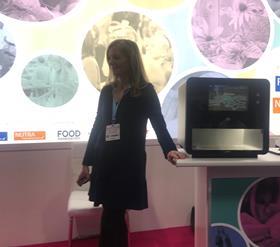
3D-printed food could prove an unexpected way of getting kids to eat more fresh produce, the co-founder of a Spanish tech company has claimed.
Lynette Kucsma from Natural Machines took to the stage at The Ingredients Show in Birmingham to showcase her company’s Foodini 3D printer, which is aimed at both commercial and domestic use and is already being used in professional kitchens.
The device is capable of a wide variety of applications and works by users entering their own ingredients and selecting a design for the final creation. One example given was 3D-printed sweet mash in the shape of a sweetcorn, while fruit juices could be presented in a three-dimensional solid form, adding interest and excitement to dishes.
Kucsma said the approach offered countless opportunities for creativity, citing the example of a spinach quiche in the shape of a dinosaur that she had created for her children. “We use it as a way to get kids to eat more veg,” she explained. “My son would only eat broccoli florets and leave the rest so there’s food waste there. This way I can chop up the whole broccoli, stem and all, print it [in a new shape] and my son will eat everything. It’s an opportunity for people to use their own fresh ingredients.”
Kucsma acknowledged there is still scepticism around 3D-printed food, but insisted this comes from the fact it is still a fledgling technology that people do not yet fully understand. “We do not think of it as the death of fresh foods, in fact it’s about getting more fresh into our diets,” she said. “It’s not scary or as crazy as it sounds. If you eat anything from a food manufacturer then you are already practically eating 3D-printed food - we’ve just shrunk the concept down and let you use it on your own as a kitchen appliance.”
Foodini currently costs around $4,000 but Kucsma said that, much like with microwaves, in the future consumers will be able to select from more basic models at much lower prices or more premium versions. The Internet of Things-connected technology also offers many possibilities for the kitchens of the future, she added, such as creating individual nutritional profiles for each user, and she forecast that 3D printers will become commonplace in consumers’ kitchens within 10-15 years.
The device has limitations. You can’t add, for example, whole carrots without chopping them up first, and current iterations cannot cook the food - though that is planned for future generations.
But Natural Machines said taste tests received an overwhelmingly positive response, and the devices are also not intended to replace chefs, but can simply automate parts of the cooking process that would previously be done by hand and take longer.



